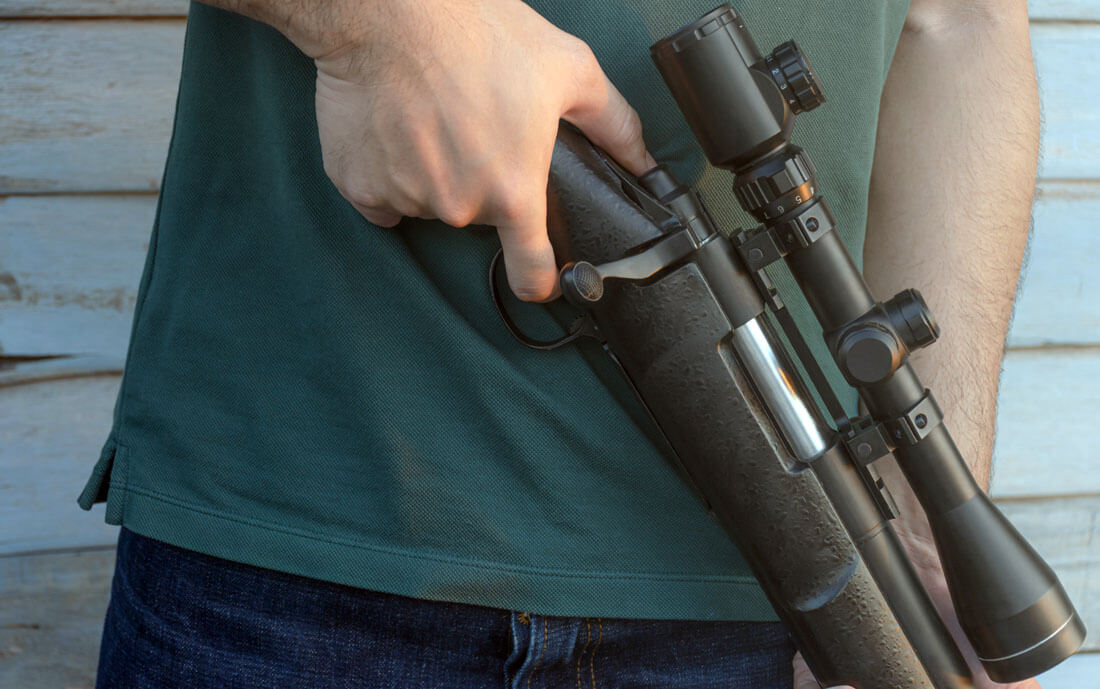Are you looking for the best rifle scopes for you? In this complete buying guide, we compiled all the details including reviews of top brands, features, and specifications to have in mind.
Whether we’re talking about hunters, the police, military or others, they all need the right rifle scope by their side. It’s the one instrument that can deliver precision while shooting at a distance.
And although some may say that few things have changed in the rifle scope industry, we beg to differ. With so many manufacturers, products, materials, and options, it’s evident that a lot is happening on the market.
More importantly, what rifle scope will give you more bang for your buck? We have created a list of some of the best shooting scopes on the market which have been tested and reviewed by professionals.
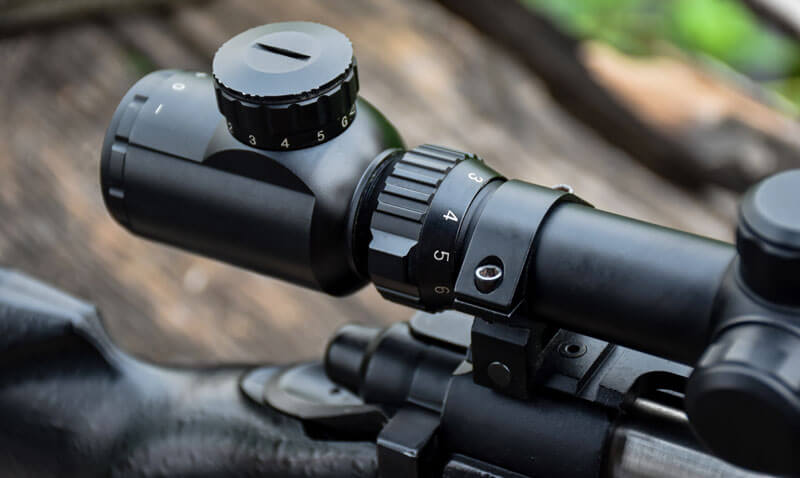
The 18 Best Rifle Scopes
Gear Odds Recommendation
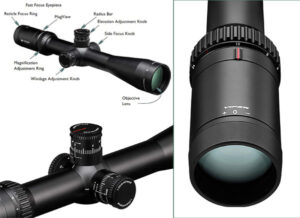
1. Vortex Optics Viper HS-T Second Focal Plane Riflescopes
Even though it’s found in the ‘under a thousand dollars’ category, this Vortex model isn’t much different than the high-end ones. The multi-coatings are ‘to blame’ for the excellent color richness in the images as well as the brightness. Furthermore, the system of turrets is very easy to modify with just a couple of finger clicks. The tube is argon-purged and O-ring-sealed, too.
Nonetheless, some users weren’t entirely satisfied with the return-to-zero setup on the turret system as it requires a bit of practice.
What about some other features? They are:
Zoom range: 4 times
Tube size: 30 millimeters
Objective lens diameter: 44 millimeters
Sunshade included
Magnification: 4-16 times
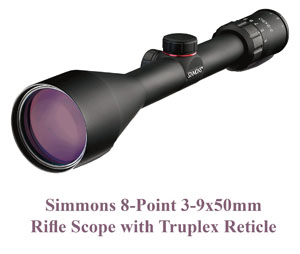
2. Simmons 8-Point Rifle Scope with Truplex Reticle
Considering the price, this is a fair rifle scope to get. Although it lacks some features when compared to the others, it gives users a chance to get a good shot.
For starters, it’s made to be durable with functional options. Moreover, it has an adjustment system for wind and elevation. To accompany this, there are coated optics. They give away a bright image.
Here are some more detailed features:
Magnification: 3-9 times
Diameter of objective lens: 50 millimeters
Eye relief: 3.74 inches
Weight: 13.2 ounces
Water and fog proof
Adjustment range: 60 inches at 100 yards

3. UTG BugBuster Scope, AO, RGB, Mil-dot
Even though this is a cheaper scope, it provides some useful features. Starting from the mil-dot reticle, which is illuminated up to the side focus, it has plenty of them. Not to mention that turret adjustments can be made on it. This makes it more variable.
Aside from these, though, some users complain that it isn’t very durable and is prone to some damages. Also, some had trouble with the quality of the optics. Still, all things considered, it’s a fair model for the price. Some more detailed specifications are as follows:
Size of tube: 1 inch
Weight: 13.9 ounces
Dimensions: 9.8 x 3.4 x 3.9 inches
Magnification: 3-9 times
Diameter of objective lens: 32 millimeters
Check and out more reviews about the 9 cheap riflescopes under $100
Affordable Long Range Scopes
An interesting development in the field of optics has been the introduction of long range riflescopes.
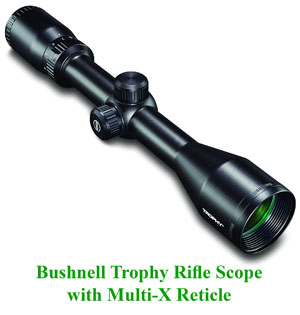
4. Bushnell Trophy Rifle Scope with Multi-X Reticle
What makes this scope special is its ability to resist shock, water, and fog completely. It consists of a tube, which is 1 inch long and has a saddle that’s integrated into it.
When speaking about the glass, it’s definitely one of the top people can get for this price. And the duplex reticle contributes to the accuracy. Because of this, it’s recommended for hunting.
However, people reported that they had issues with the focus as well as the lack of caps. For those willing to find out more, we present other specifications:
Weight: 14.2 ounces
Dimensions: 16.2 x 3 x 2.4 inches
Color: Matte black
Magnification: 3-9 times
Diameter of lens: 40 millimeters
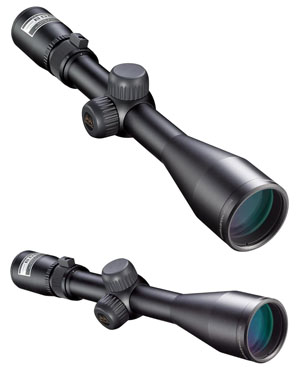
5. Nikon Buckmasters II 3-9×40 BDC
As usual, Nikon is a brand that tends to include its recognizable BDC reticle in the scopes. Because of this, the shooter can estimate the drop of the bullet in advance.
Of course, there are other details to consider regarding this scope, though. It comes with lenses that are multi-coated for an enhanced image. Not to mention that it’s very bright and accurate. Aside from this, the scope can be utilized in different weather conditions. It’s made to resist both water and fog.
However, potential buyers should know that people experienced mounting issues on various rifles.
What follows are some more specifications:
Magnification: 3-9 times
Diameter of objective lens: 40 millimeters
Weight: 1.4 pounds
Dimensions: 15.8 x 3.5 x 4.8 inches
Limited lifetime warranty
You have a chance to watch the reviews about the 8 riflescopes under $200
Best Low Light Scope under $500
The scope to use in low light conditions is a variable power scope with an illuminated reticle. With a variable power scope, you can adjust the magnification so that you can see your target clearly while using low light.

6. Vortex Optics Crossfire II Second Focal Plane Rifle Scope
This is a classical model. And it possesses some of the classic Vortex’s features. Notables ones are definitely the coatings of the optics. Furthermore, they are resistant and anti-reflective. Due to this, the scope can’t be damaged easily and it has an improved transmission of light.
As for the design, it’s made of aluminum used in aircrafts with turrets that can be adjusted to wind or elevation results. Yet when the settings are on the high mag, the clarity and eye relief tend to suffer.
Interested to discover more details? Here are some:
Magnification: 4-12 times
Objective lens diameter: 44 millimeters
BDC reticle
MOA turrets that can be reset
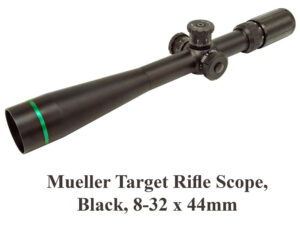
7. Mueller Target Rifle Scope
This scope represents another affordable opportunity with quality features. Moreover, it sports a solid construction with nice optics that give clear views.
Yet, it turns out that it isn’t suitable for all shooters. Mainly, this is because it operates on long distances. Still, the high magnification of 32 times goes ahead of many other models. Another thing to mention is the easily adjustable settings that come in handy, especially when shooting with weapons with heavy recoil.
Some other specifications are as follows:
Diameter of objective lens: 44 millimeters
Eye relief: 4 inches
Size of tube: 30 millimeters
Weight: 1.63 pounds
To improve your shooting experience check this guide about riflescopes under $500
Best FFP Scope under 500 USD
Anyone who spends a significant amount of time shooting at the range, knows that riflescopes come in all different shapes and sizes. However, there are certain differences between scopes, which make some riflescopes more suited for particular jobs than others.
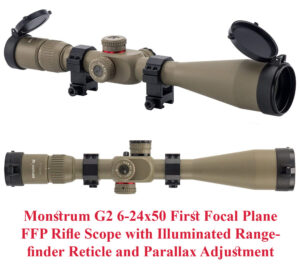
8. Monstrum G2 First Focal Plane FFP Rifle Scope
Although the brand may not be familiar to many, this model is worth users’ attention. Why? Firstly, it features an illuminated rangefinder reticle. This means that it can be adjusted for day and night utilization. Also, it comes with a great eye relief of 4-4.5 inches.
Not to forget, the scope is suitable mostly for weapons with high recoil. This along with the zooming capabilities attracts hunters to this product. Despite all of this, users complain that the rings that come with it are too high to mount.
More features and specifications are:
Magnification: 6-24 times
Diameter of tube: 30 millimeters
Range of the scope: middle to long-range on more than 1500 yards

9. Primary Arms SLX 3-18x50mm FFP Rifle Scope
The ACSS line of rifle scope includes multiple models that differ among themselves regarding settings and power. The bottom line is that they all have quality optics for the price that users can rely on.
Thanks to the illuminated reticle mil bar, users get swiftness when shooting at short ranges and great performance at medium ranges. The lifetime warranty is a big advantage.
Some buyers, on the other hand, thought that it’s a bit heavier.
Other specifications are:
Click value: 1/2 minutes of angle
Tube diameter: 30 millimeters
Magnification: 1-8 times
Eye relief: 3.50-3.30 inches
Best Hunting Rifle Scopes under 500 USD
The best hunting rifle scopes are typically made out of glass with high magnification rates. The higher the magnification number, the more “real” the figures appear. The highest magnification systems are typically multi-coated, so they reflect light more efficiently and reduce glare and reflections.
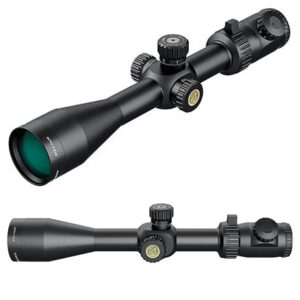
10. Athlon Optics, Argos BTR, Riflescope
When a company that manufactures telescopes starts making riflescopes, it looks like this. Athlon Optics made this model extremely powerful, at least in the magnification department. And it delivers suitable optics when you consider that the scope’s fully multi-coated.
The build is pretty strong and sturdy. One of the reasons is the aircraft-level aluminum it’s made of.
To a few customers, the clarity isn’t high-level at a long distance and the rings weren’t of a suitable height. Some of the highlight features include:
Magnification: 8-34 times
Material: aluminum
Tube diameter: 30 millimeters
Objective lens diameter: 56 millimeters
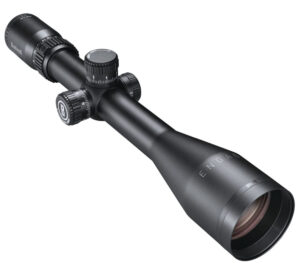
11. Bushnell Engage Riflescope, Matte Black
Besides delivering crisp and clear images, the lens’s coatings are protective, too. They make the model resistant against dust, oil, debris, and similar. Having said that, it’s waterproof and fog proof even in extreme conditions. The side Parallax modifications come in handy while hunting. So do the locking turrets.
What a couple of users found as a downside was that the model doesn’t come with a sunshade and the size of the reticle. Anyway, catch a glimpse of the following features:
Weight: 23.7 ounces
Eye relief: 3.6 inches
Magnification: 6-24 times
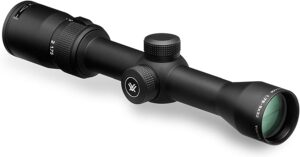
12. Vortex Optics Diamondback Second Focal Plane Riflescopes
This scope is one of the stars in the Diamondback lineup of products. Additionally, it can be used for multiple applications like slug shotgun, hunting big game, and others, to name just a few. That is enabled due to the eyepieces that focus quickly. What’s more, the lenses let through enough light even in darker periods of the day.
The design is resistant against shocks as well as water and fog. It provides an extra level of camouflage, too. Connected to this, the tube is made out of just one piece.
However, some notes can be improved. An example is the absence of a flip-up lens cap. For those who are interested, these are some of the highlight specifications:
Fully multi-coated lens
Windage adjustment knob
Objective lens diameter: 32 millimeters
High-end aluminum alloy construction
Magnification: 1.75-5 times
Best Budget Rifle Scopes (Price range $1000 to $2000)
There are many excellent makes of riflescopes, each with their own strengths and weaknesses. Some are made for target practice, some for hunting. If you plan on shooting long distances (over 300 yards), you will want a scope that will magnify the image to a high degree. Picking a scope that is also windage and elevation compensated is important, too.
Since the scope mount itself becomes the optics, it may be possible to get out of alignment when shooting. This can lead to an error in range estimation. Price may be an important factor to consider, as well.
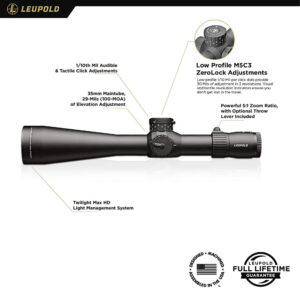
13. Leupold Mark 5HD 5-25x56mm Riflescope
With an increasingly long-lasting design that’s light at the same time, Leupold has a real asset in this model. Plus, it’s resistant against scratches.
One of its other perks is the long-distance shooting capabilities. Moreover, it’s an FFP model that delivers clear pictures with minimum glares.
Let’s note here a few very minor things that some buyers noticed. According to them, the CCH reticle waskind of busy and needs practicing. Also, the TMR reticle isn’t illuminated.
Here are the other features and specifications:
Magnification: 5-25 times
Weight: 30 ounces
Zoom ratio: 5:1
Tube size: 35 millimeters
Objective lens diameter: 56 millimeters

14. Vortex Optics Razor HD Gen II First Focal Plane Riflescope
Besides the ruggedness and durability, the design of the scope incorporates user-friendliness with big dials and other modifications. Further, there are many reticle styles to choose from. The lens system is multi-coated and has a very high percentage of light transmission. Waterproofing, as well as fog proofing, are, of course, guaranteed.
According to a few users, the size and weight are the two categories this model doesn’t entirely excel at.
Despite this, extra features include:
Magnification: 3-18 times
Zoom range: 6 times
Objective lens diameter: 50 millimeters
Tube size: 34 millimeters
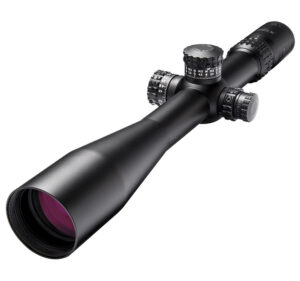
15. Burris Optics XTR II Riflescope 8-40x50mm
Usually, Burris is known for budget models, but with this scope, they go into the business of more expensive ones. With massive magnification capabilities and easy adjustments, one of its most suitable uses is sandbag shooting, among others.
The size, as well as the fact that the clarity isn’t the same when the magnification is on a maximum level, are among the things some people weren’t fans of.
To understand the model better, it’s helpful to dive deeper into the other specifications:
Magnification: 8-40 times
Tube size: 34 millimetres
Objective lens diameter: 50 millimeters

16. Swarovski Riflescope Z5 5-25×52 BT
One of the things that help this scope stand out is its impeccable accuracy. The quality glass delivers vivid images. Additionally, the scope has a five-time zoom as well as adequate magnification powers.
When users hold it, they can immediately see that the scope is solid, yet light at the same time. The design is rugged and very contemporary as can be expected from Swarovski.
A small downside is that the company doesn’t make flip-open objective covers for the scope.
What follows are the scope’s highlight features and specifications:
Objective lens diameter: 52 millimeters
Eye relief: 3.74 inches
Field of view: 7.3-1.5 meters at 100 meters
Weight: approximately 495 grams
Magnification: 5-25 times
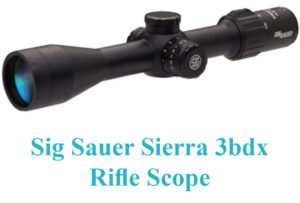
17. SIG Sauer Sierra 3BDX Rifle Scope
Hunting can be considered as one of the primary uses of this scope. Additionally, its greatest asset is the smart technology inputted in the model aside from a traditional reticle. It wakes up when it detects motion and switches off when there is none.
With that being said, the lens coatings minimize reflections off surfaces and offer enhanced and augmented images.
It’s safe to say that smart technology may not be for all hunters, especially those who like to do it the old-school way. Also, the magnification power can be made better.
If your interest is piqued, these are the rest of the specifications and features:
Tube diameter: 30 millimeters
Objective lens diameter: 44 millimeters
Adjustment increments: 0.25 minutes of angle

18. Zeiss Conquest V6 3-18×50 ZMOA Reticle w/BDC Turret
With a system of HD lenses and special coatings, Zeiss proves it cares for the quality of the image the users receive on the other end of the scope. Having said that, the scope is suitable for shooting from long distances.
Many customers praise the design as modern-looking and sleek. Also, it provides a rugged effect and is pretty light and compact.
It’s worth mentioning that one of its cons is the price, which is a bit higher when compared to other products on the market. If this scope caught your attention, check out these specifications as well as features:
Magnification: 5-25 times
Made in Germany
Warranty: 5-year no-fault policy and limited lifetime warranty
Objective lens diameter: 50 millimeters
Buyer’s Guide
Rifle Scope are versatile. Not only can they be utilized for various purposes, but their price varies, as well. Because of this, hunters and shooters should identify their budget and preferences. Understandably, the cheaper models may lack some more advanced features and vice versa. Also, it’s not the same to get a scope for deer hunting and varmint hunting or any other type of shooting. This is because the specifications for each of those needs are different. So, to make things clearer, the buyer should know the terms related to the rifle scope.
Especially people that are new to this, struggle with them, though. There are many technical words to follow. Therefore, it can be tough to understand them completely. In turn, this impacts the choice of the right rifle scope for them.
Yet users should have in mind that the technical jargon isn’t as important as the meaning. Before they purchase the product, they should be familiar with what all features mean. To keep you posted and help you with this, here we’ll go over the details.
What’s a Rifle Scope?
A rifle scope is an optical device that is attached to the end of a rifle. It helps accuracy by providing magnification, reticles for aiming, and/or illumination of the target.

A rifle scope typically has two or more lenses, but typically one lens with magnifying power. They are usually made of glass, but some are plastic. Some riflescopes use prisms for magnification, while others use transparent lenses with no optical elements in between the lenses.
Types of rifle scopes
Illuminated reticle scopes. As the name implies, they contain lighting elements to make the reticle visible in low-light conditions; often LED lighting is used.
- Multi-purpose scopes:- Also called “all-in-one” or “combo” scopes, they combine a riflescope with another feature, such as a laser rangefinder, camera, thermopile, or even a projector for use in low light conditions. The most popular models are the M3 Scout scope and Burris Fullfield III.
- Fixed power scopes:- The magnification of these scopes remains constant throughout the magnification range, unlike variable power riflescopes which zoom in or out as needed. Fixed power scopes are available with or without reticles, though most of the higher end models come with an illuminated reticle.
- Variable power scopes:- These scopes vary the magnification as needed, such as in low light or long distance conditions. These are the most common type of riflescopes used because they are more versatile, are less expensive, and can be used with other optical devices.
- Optical tube scopes:- These are the highest quality scopes for serious shooters. They are the most expensive and the most powerful.
The main use of riflescopes is for target shooting and hunting. They can also be used to aim at objects at a distance and for observation and surveillance.
Read more for the best USA made riflescopes reviews
Scope Magnification
Magnification comes first because it influences many other features. That’s why it should be thoroughly understood.
Many people think of it as a microscopic effect. But it’s not. In fact, rather than enlarging the objects, it’s responsible for making them look closer. Moreover, the target remains the same. As for types, there are two. Riflescopes come either with fixed magnification or a variable one. For instance, when buying, people may see this next to the products – 8×10 or 7-8×10. The numbers 8 and 7-8 in the example represent the magnification. The first one is fixed and the second one is variable.
More precisely, the fixed magnification ensures that the object appears closer for a fixed amount of ‘times’. On the other hand, the variable one lets the shooter adjust the scope between a certain number of times.
In practice, the scopes with fixed magnification have proven to be more durable. So, the military uses them. Also, they have less failing parts as they don’t move frequently. Despite this, the fixed scopes don’t offer many options to the users.
Opposed to them, the versatile scopes are versatile. Yes, they incorporate moving parts. But because of them, they can operate on various ranges. This makes it clear why the final scope choice comes down to the buyers’ needs and wishes.
Another detail to mention here is that some riflescopes don’t have magnification. The number of times the object is closer is one. This makes them suitable for those that want the weapon for personal defense.
Main Tube
All riflescopes have a main tube. It plays a big role in their durability and targeting. Actually, main tubes with a big diameter are responsible for an increased adjustment range. In return, it impacts targeting on long distances as well as the long-lasting of the product.
Generally, the diameter of the tube ranges between 1 inch and 30 millimeters or 34 millimeters. However, those that have the latter diameter of 34 millimeters tend to cost more. Not to mention that their weight is increased due to the additional material used in them. Because of this, they can be tougher to mount. To evade these troubles, hunters usually go for a one-inch tube. It has proven to be enough, at least for this purpose.
Objective Lens
The objective lens comes in various sizes, starting from 20 millimeters to 72 millimeters. However, the most common one is 40 millimeters to 50 millimeters.
Basically, it is situated opposite of where the shooter places their eye. While it is closely connected to the magnification, it doesn’t have its capabilities.
Still, the lens fulfills one role. It is responsible for gathering light, ensuring that the views are bright enough. This can come in handy in low-light situations. Moreover, as magnification increases more light is needed for quality views. That’s when the objective lens should be increased, as well.
However, there are certain issues with a lens whose size is too big. The main one is related to placing the scope on the rifle. It should be closer to the bore axis in order to be efficient. And smaller lens size allows this. Therefore, to avoid any troubles, try to find rings that have standard height and a scope that can be easily placed on them. Also, understand that a larger objective lens isn’t always necessary. So, don’t make compromises on account of the quality of the other features like glass and lens coatings.
Lens Coating
Aside from getting a rifle scope with a large objective lens, there are more options for receiving clear views. They are still related to the lens. And they come in the form of lens coatings.
Basically, what they do is better the light transmission. This is done by filtering the spectrum of light. Also, coatings can save the lens from scratching, lower the glare as well as resist fogging. While the details behind all of this can be complicated, users should be familiar with the four main types of lens coatings.
Firstly, there is a coated lens. It consists of only one chemical cover that is made to lower the glare. Then, the fully coated lens can be found in certain rifle scope. This type can be recognized by the fact that the coating varies between the lenses. Furthermore, each of them incorporates one coating. What follows is the multi-coated objective lens. As the name suggests it consists of more coatings. And they fulfill various tasks, including visibility improvement.
Finally, to maximize the resistance and performance, shooters go for fully multi-coated ones. The lenses, in this case, possess various coatings, responsible for enhanced performance and functionality of the rifle scope in general.
Eye Relief
Eye relief goes hand in hand with alignment. In fact, it represents the distance between the eye and the scope that’s required to maintain the right alignment. If the eye is either too close or too far, the accuracy will suffer. Not to mention that the shooter may feel strain in the eye.
To evade this, people should follow certain requirements when it comes to eye relief. It’s true that many scopes are suitable for all users. Yet there are some that need more eye relief. Especially, people that wear glasses fall in this category. For them, an eye relief of half an inch or an inch would work nice. But this is dependent on their glasses.
Another situation where a longer eye relief is necessary is when the shooting weapon has big recoil. In this case, the scope can get into the eye of the shooter as the firearm kicks with increased strength. Related to the firearm, some weapons are made with a point for mounting that’s located far. Therefore, a regular scope can’t work, which calls for a longer relief length.
Putting all of this aside, buyers should acknowledge that they shouldn’t purchase an eye relief that’s too long. An excessively short one isn’t recommended either. Instead, a relief between three and five inches should be enough for most shooters.
Adjustments – Simple Scopes and Turrets
When picking a suitable rifle scope, people should consider the adjustments, as well. The truth is that there are adjustments for the elevation and wind. More precisely, in the case of elevation, which consists of going up and down, a few details shouldn’t be overlooked.
For starters, the simple scopes are known to have adjustments with caps. What is meant by this is that the screws have caps. Their role is to keep them secure and stop possible changes. Therefore, they can be found mostly in scopes for hunting and close ranges.
On the other hand, the turrets are a bit complicated. In their case, shooters can adjust elevation and wind whenever they prefer during the shooting. Because of this, every shot matters and they can make it in accordance with their preferences. So, snipers and scopes meant for long distances incorporate them.
Another thing to have in mind is that the adjustments are closely related to reticles. In fact, it’s recommended to use the same adjustment as the reticles. More details about this in the following paragraphs.
Reticles and Focal Plane
One of the key aspects that determine the choice of the right scope is the reticle. This is due to the fact that there are various reticle options. And to make sure they get the right one to go with their firearm, shooters should understand them and their impact.
In its base, the reticle is a symbol placed in the focal planes inside the scope that’s responsible for the aim. For this reason, it impacts the accuracy of the shots. Connected to this, users usually associate reticles with long ranges. Yes, many of them provide accurate shots at longer distances. But still, there are also many that operate nicely on medium and short distances.
When it comes to short-distance shooting, the scopes with reticles in shapes like dot, chevron or circle are recommended. Although scopes with these reticles are low in power, they serve well for home defense and some types of hunting.
Hunters and hobbyists will find pleasure in the standard reticle and the duplex one, as well. Understandably, the first one is simpler to use. It actually looks like a cross amid thin lines. The duplex reticle is its upgrade. It starts with thick lines at the edges, which transform into thinner as they get near the center. Thanks to this, the reticle is clearly visible in low-light conditions.
Finally, scopes intended for long ranges tend to have a reticle for telling the drop of the bullet or the range. They can be bought in two versions – Mil and MOA. Both of them work best on distances between 300 yards and 1000 yards. That’s when the views they provide are the most accurate. While there are some minor differences between the two versions, they aren’t really vital to buyers. What’s important for them is to decide which version they prefer based on something they have read, some reviews or just their own preferences.
Leaving the patterns aside, optics with colored and illuminated reticles can also be found on the market. What separates them is that the colored ones are more common for short-distance scopes. The illuminated reticles can be a part of these scopes, but they are used in high-powered ones, as well.
Glass
If people wonder which glass to pick, they should look at the price. In this case, the buyer receives what they paid for. Moreover, cheap materials usually don’t go inside a high-quality glass.
What makes a good glass, though, is the dispersion of light. The one whose optic provides low dispersion is responsible for preventing color fringing. Therefore, the views are sharp, colorful, and have high contrast. Related to bright and clear images, the lens should be multi-coated to maximize this effect. Not to mention that this way the glass could resist moisture, too.
Things to consider
Everyone has different budgets when it comes to picking a rifle scope. Some are willing to invest more money while others are content with affordable models. Understandably, as the price goes higher the features the scope offers tend to be more premium in quality. Also, expensive models are known to be more resistant and durable.
But in the end, it all comes down to the buyers’ preferences. They should sort out their priorities and decide what they’re willing to sacrifice on account of the price. Having all of this in mind, it should be noted that in every budget category there are decent scopes to get. So, here we’ll present those above.
Priorities and Budget
These are the two most defining factors when choosing a rifle scope. On one hand, you have the money you’ve set apart. And then, there are the scope’s important characteristics you prioritize. Usually, a higher price indicates a product with more features. That can be said about rifle scope, too.
For that reason, how much money you want to spend on a rifle scope will most likely determine the features, magnification power, quality of glass, and similar.
It’s worth noting here that sometimes highly-priced products aren’t exactly for everyone. More precisely, if you’re a newbie, you probably don’t need an insanely professional scope that you’ll pay a lot for. However, you shouldn’t find yourself in a situation where you pay too little for a product that breaks down after a couple of usages.
Warranty Period
People don’t say in vain that scopes can be a real investment. That’s why buyers should have some kind of protection if something is wrong with the product. The warranty has that role.
The period of protection can vary from company and model to the next. To illustrate, some offer life-long warranties against anything. Some limit them to life-long ones but cover only against defective manufacturing.
Because of this, all users should carefully study what’s written in the warranty. Only that way you will know what your scope is protected against. Also, buyers can check if there is an option for registering the product.
Reticle Alternatives
Buyers have a plethora of alternatives when it comes to choosing the right reticle. That makes matters even more complex for the non-professionals. The available options usually range from BDC and Mil-Dot to duplex and MOA.
The more you want in a reticle, the higher the price is. And that’s expected when it comes to scopes.
Having said that, users averagely go for the duplex one. One of the reasons is because it performs well in most average tasks.
Parallax Modifications
The ability to adjust the scope’s parallax is often reserved for fancier and, thus, pricier models. For those who aren’t very familiar with the term, we’ll explain in the simplest words. It’s this movement that occurs when the user turns their head or eyes in a different location.
Does this play a big role while you’re shopping for a scope? The answer is practically defined by the magnification features, as well as, the distance from where you’ll hunt and even what you’ll aim at.
Understanding Rifle Scope Vocabulary and Information
It’s no secret that people who are experts at scopes use a lot of acronyms, terms, and a vocabulary that may appear weird to amateurs. For example, what if we told you that the distance you hunt at is too great that you need a turret and you have no idea what that is? To evade this uncomfortable situation, buyers should learn at least the main specific words (if not all) related to riflescopes. That’s the way for you to get the most out of your scope research as well as shopping for it. Plus, buyers can find plenty of resources online and can even ask for a direction from an expert they know.
Matching the Scope with the Firearm
The following may come as a surprise to some. Not all scopes are adequate for all firearms. Just as users know all the details about their rifles and such, they should know everything about the scope they’re looking to purchase. With the right match, the buyers ensure that they’ve made the right investment. What’s more, they’ll stay safe as a mismatch can inflict serious damage on a user’s face.
My final words
All things considered, choosing the right rifle scope involves going through many details. For starters, you should know specific features that determine the quality of the scope. After understanding their meaning, next is going through reviews and exploring the models that are worth getting in every price range. We hope we helped you with this in the previous paragraphs. Yet the final decision falls completely on you.
So, which rifle scope are you getting? Or do you have any more tips or models to share? Talk with us here.

